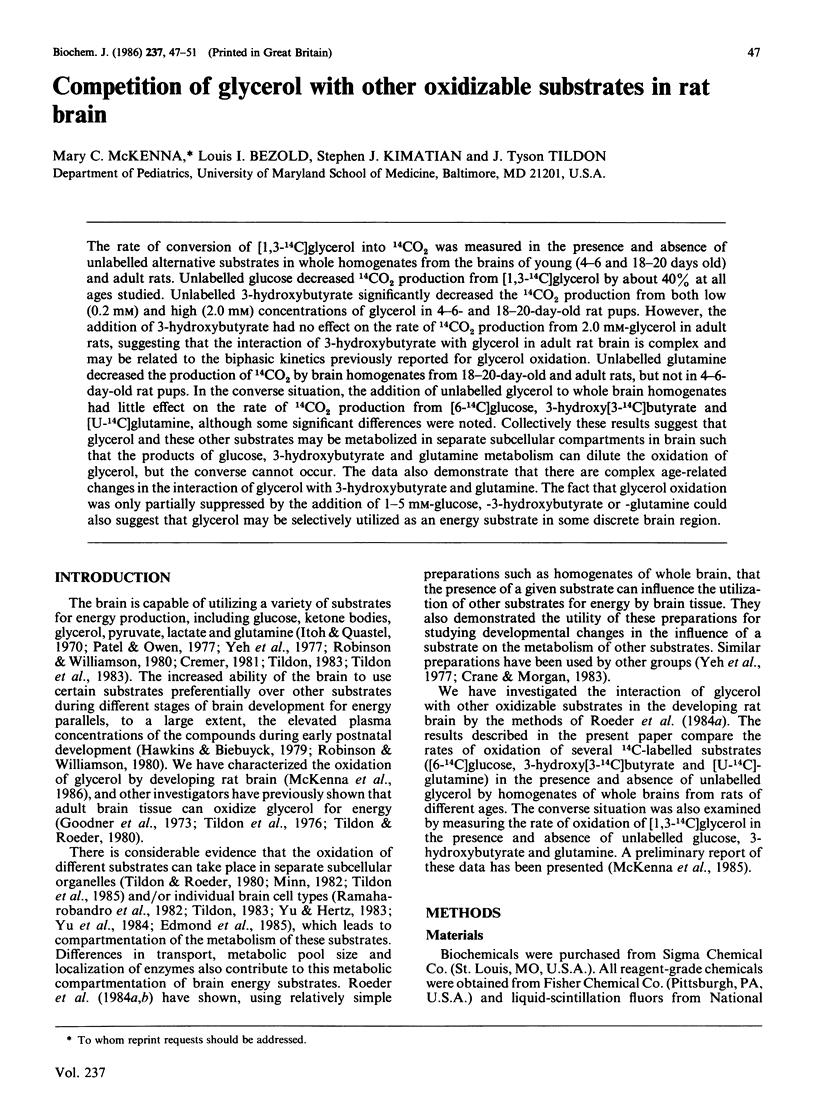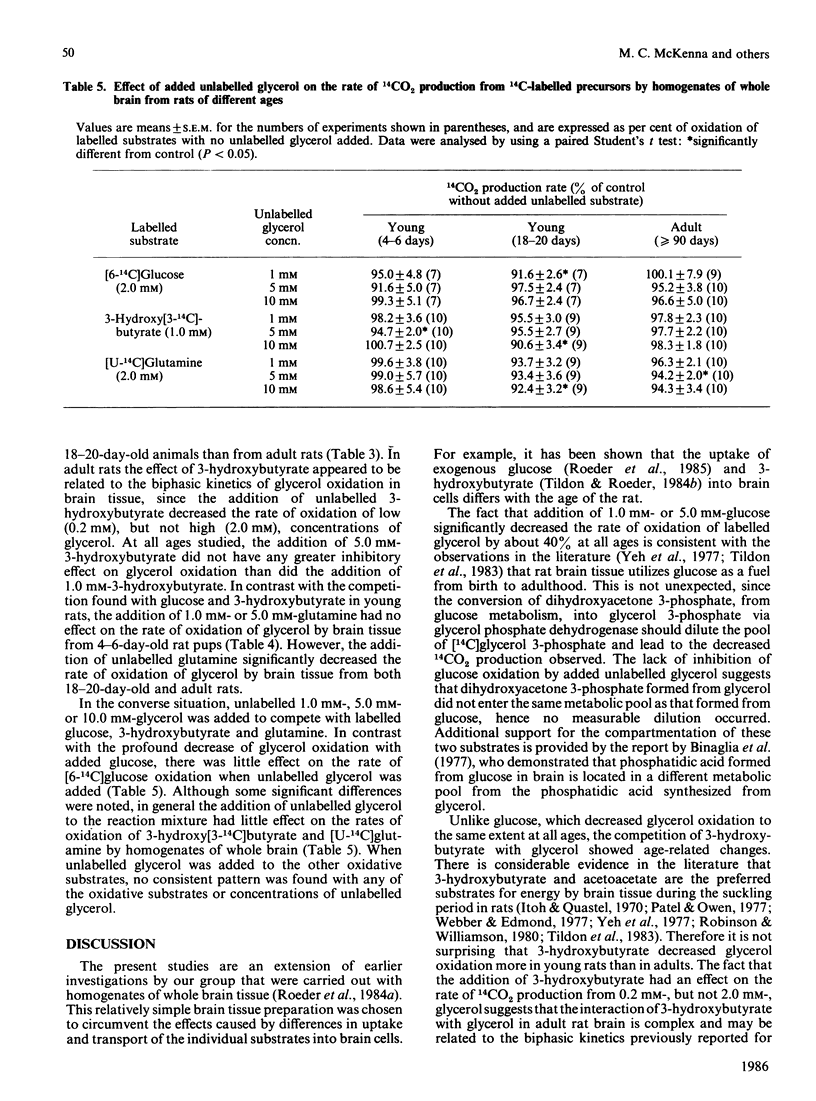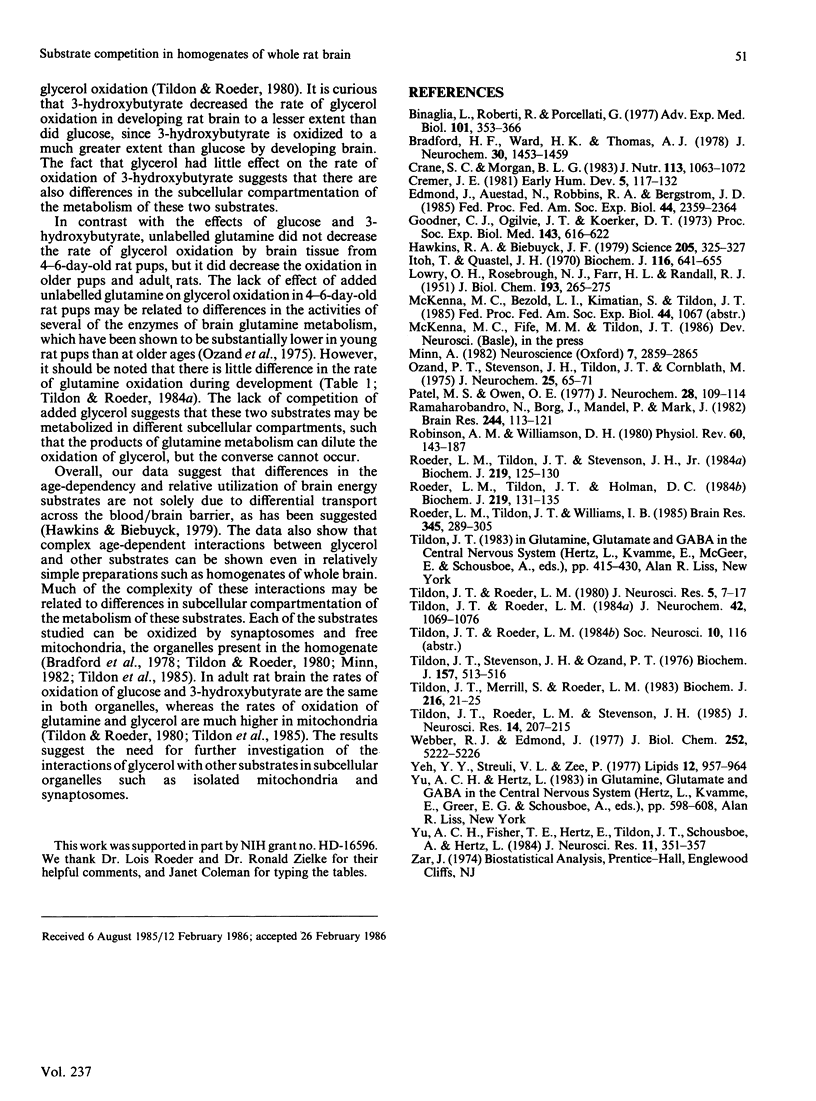Abstract
The rate of conversion of [1,3-14C]glycerol into 14CO2 was measured in the presence and absence of unlabelled alternative substrates in whole homogenates from the brains of young (4-6 and 18-20 days old) and adult rats. Unlabelled glucose decreased 14CO2 production from [1,3-14C]glycerol by about 40% at all ages studied. Unlabelled 3-hydroxybutyrate significantly decreased the 14CO2 production from both low (0.2 mM) and high (2.0 mM) concentrations of glycerol in 4-6- and 18-20-day-old rat pups. However, the addition of 3-hydroxybutyrate had no effect on the rate of 14CO2 production from 2.0 mM-glycerol in adult rats, suggesting that the interaction of 3-hydroxybutyrate with glycerol in adult rat brain is complex and may be related to the biphasic kinetics previously reported for glycerol oxidation. Unlabelled glutamine decreased the production of 14CO2 by brain homogenates from 18-20-day-old and adult rats, but not in 4-6-day-old rat pups. In the converse situation, the addition of unlabelled glycerol to whole brain homogenates had little effect on the rate of 14CO2 production from [6-14C]glucose, 3-hydroxy[3-14C]butyrate and [U-14C]glutamine, although some significant differences were noted. Collectively these results suggest that glycerol and these other substrates may be metabolized in separate subcellular compartments in brain such that the products of glucose, 3-hydroxybutyrate and glutamine metabolism can dilute the oxidation of glycerol, but the converse cannot occur. The data also demonstrate that there are complex age-related changes in the interaction of glycerol with 3-hydroxybutyrate and glutamine. The fact that glycerol oxidation was only partially suppressed by the addition of 1-5 mM-glucose, -3-hydroxybutyrate or -glutamine could also suggest that glycerol may be selectively utilized as an energy substrate in some discrete brain region.
Full text
PDF




Selected References
These references are in PubMed. This may not be the complete list of references from this article.
- Binaglia L., Roberti R., Porcellati G. A study on the turnover of rat brain phosphatidic acid through the glycerol-phosphate pathway. Adv Exp Med Biol. 1978;101:353–366. doi: 10.1007/978-1-4615-9071-2_33. [DOI] [PubMed] [Google Scholar]
- Bradford H. F., Ward H. K., Thomas A. J. Glutamine--a major substrate for nerve endings. J Neurochem. 1978 Jun;30(6):1453–1459. doi: 10.1111/j.1471-4159.1978.tb10477.x. [DOI] [PubMed] [Google Scholar]
- Crane S. C., Morgan B. L. The effect of alterations in ketone body availability on the utilization of beta-hydroxybutyrate by developing rat brain. J Nutr. 1983 May;113(5):1063–1072. doi: 10.1093/jn/113.5.1063. [DOI] [PubMed] [Google Scholar]
- Cremer J. E. Nutrients for the brain: problems in supply. Early Hum Dev. 1981 May;5(2):117–132. doi: 10.1016/0378-3782(81)90043-8. [DOI] [PubMed] [Google Scholar]
- Edmond J., Auestad N., Robbins R. A., Bergstrom J. D. Ketone body metabolism in the neonate: development and the effect of diet. Fed Proc. 1985 Apr;44(7):2359–2364. [PubMed] [Google Scholar]
- Goodner C. J., Ogilvie J. T., Koerker D. T. The metabolism of glycerol by hypothalamic and pituitary tissues in vitro in the rat. Proc Soc Exp Biol Med. 1973 Jul;143(3):616–622. doi: 10.3181/00379727-143-37378. [DOI] [PubMed] [Google Scholar]
- Hawkins R. A., Biebuyck J. F. Ketone bodies are selectively used by individual brain regions. Science. 1979 Jul 20;205(4403):325–327. doi: 10.1126/science.451608. [DOI] [PubMed] [Google Scholar]
- Ito T., Quastel J. H. Acetoacetate metabolism in infant and adult rat brain in vitro. Biochem J. 1970 Feb;116(4):641–655. doi: 10.1042/bj1160641. [DOI] [PMC free article] [PubMed] [Google Scholar]
- LOWRY O. H., ROSEBROUGH N. J., FARR A. L., RANDALL R. J. Protein measurement with the Folin phenol reagent. J Biol Chem. 1951 Nov;193(1):265–275. [PubMed] [Google Scholar]
- Minn A. Glutamine uptake by isolated rat brain mitochondria. Neuroscience. 1982;7(11):2859–2865. doi: 10.1016/0306-4522(82)90108-7. [DOI] [PubMed] [Google Scholar]
- Ozand P. T., Stevenson J. H., Tildon J. T., Cornblath M. The effects of hyperketonemia on glutamate and glutamine metabolism in developing rat brain. J Neurochem. 1975 Jul;25(1):67–71. doi: 10.1111/j.1471-4159.1975.tb07695.x. [DOI] [PubMed] [Google Scholar]
- Patel M. S., Owen O. E. Development and regulation of lipid synthesis from ketone bodies by rat brain. J Neurochem. 1977 Jan;28(1):109–114. doi: 10.1111/j.1471-4159.1977.tb07715.x. [DOI] [PubMed] [Google Scholar]
- Ramaharobandro N., Borg J., Mandel P., Mark J. Glutamine and glutamate transport in cultured neuronal and glial cells. Brain Res. 1982 Jul 22;244(1):113–121. doi: 10.1016/0006-8993(82)90909-x. [DOI] [PubMed] [Google Scholar]
- Robinson A. M., Williamson D. H. Physiological roles of ketone bodies as substrates and signals in mammalian tissues. Physiol Rev. 1980 Jan;60(1):143–187. doi: 10.1152/physrev.1980.60.1.143. [DOI] [PubMed] [Google Scholar]
- Roeder L. M., Tildon J. T., Holman D. C. Competition among oxidizable substrates in brains of young and adult rats. Dissociated cells. Biochem J. 1984 Apr 1;219(1):131–135. doi: 10.1042/bj2190131. [DOI] [PMC free article] [PubMed] [Google Scholar]
- Roeder L. M., Tildon J. T., Stevenson J. H., Jr Competition among oxidizable substrates in brains of young and adult rats. Whole homogenates. Biochem J. 1984 Apr 1;219(1):125–130. doi: 10.1042/bj2190125. [DOI] [PMC free article] [PubMed] [Google Scholar]
- Roeder L. M., Tildon J. T., Williams I. B. Transport of 2-deoxy-D-glucose by dissociated brain cells. Brain Res. 1985 Oct 21;345(2):298–305. doi: 10.1016/0006-8993(85)91006-6. [DOI] [PubMed] [Google Scholar]
- Tildon J. T., Merrill S., Roeder L. M. Differential substrate oxidation by dissociated brain cells and homogenates during development. Biochem J. 1983 Oct 15;216(1):21–25. doi: 10.1042/bj2160021. [DOI] [PMC free article] [PubMed] [Google Scholar]
- Tildon J. T., Roeder L. M. Glutamine oxidation by dissociated cells and homogenates of rat brain: kinetics and inhibitor studies. J Neurochem. 1984 Apr;42(4):1069–1076. doi: 10.1111/j.1471-4159.1984.tb12712.x. [DOI] [PubMed] [Google Scholar]
- Tildon J. T., Roeder L. M. Glycerol oxidation in rat brain: subcellular localization and kinetic characteristics. J Neurosci Res. 1980;5(1):7–17. doi: 10.1002/jnr.490050103. [DOI] [PubMed] [Google Scholar]
- Tildon J. T., Roeder L. M., Stevenson J. H. Substrate oxidation by isolated rat brain mitochondria and synaptosomes. J Neurosci Res. 1985;14(2):207–215. doi: 10.1002/jnr.490140206. [DOI] [PubMed] [Google Scholar]
- Tildon J. T., Stevenson J. H., Jr, Ozand P. T. Mitochondrial glycerol kinase activity in rat brain. Biochem J. 1976 Aug 1;157(2):513–516. doi: 10.1042/bj1570513. [DOI] [PMC free article] [PubMed] [Google Scholar]
- Webber R. J., Edmond J. Utilization of L(+)-3-hydroxybutyrate, D(-)-3-hydroxybutyrate, acetoacetate, and glucose for respiration and lipid synthesis in the 18-day-old rat. J Biol Chem. 1977 Aug 10;252(15):5222–5226. [PubMed] [Google Scholar]
- Yeh Y. Y., Streuli V. L., Zee P. Ketone bodies serve as important precursors of brain lipids in the developing rat. Lipids. 1977 Nov;12(11):957–964. doi: 10.1007/BF02533318. [DOI] [PubMed] [Google Scholar]
- Yu A. C., Fisher T. E., Hertz E., Tildon J. T., Schousboe A., Hertz L. Metabolic fate of [14C]-glutamine in mouse cerebral neurons in primary cultures. J Neurosci Res. 1984;11(4):351–357. doi: 10.1002/jnr.490110403. [DOI] [PubMed] [Google Scholar]


